

Misconceptions regarding Java heap size arguments. We Recommend These Resources There seem to be some misconceptions regarding the Java Heap size arguments.
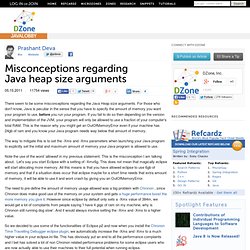
For those who don't know, Java is peculiar in the sense that you have to specify the amount of memory you want your program to use, before you run your program. If you fail to do so then depending on the version and implementation of the JVM, your program will only be allowed to use a fraction of your computer's total RAM. This is the reason why you might get an OutOfMemoryError even if your machine has 24gb of ram and you know your Java program needs way below that amount of memory. The way to mitigate this is to set the -Xms and -Xmx parameters when launching your Java program to explicitly set the initial and maximum amount of memory your Java program is allowed to use. Note the use of the word 'allowed' in my previous statement. Of course, this has angered some people who when they see the heap size in their eclipse status bar set to a high value tend to freak out. From. How websites handle multiple users simultaneously? « My Blog – My Thoughts.
This time I am sharing my discussions about how all these high traffic sites handle multiple users simultaneously.

The discussion is not specific to a certain web site but rather was related to a set of guidelines that every developer should follow to make such tasks easy. There are many things to consider. I would list down some as follows: Separating the code into distinct independent layers. A classic three tier architecture having a Presentation Layer, Business Logic Layer and Data Access Layer. I have just scratched the surface here. Like this: Like Loading... IBM Rational Performance Tester - Rational Performance Tester - Software. AIX® 5.3 TL7 or later Red Hat Desktop 4 updates 1 through 7 (on Intel® platforms) Red Hat Enterprise Linux® 4 updates 1 through 7 (on Intel platforms) Red Hat Enterprise Linux 5 updates 2 and 3 (on Intel platforms) SuSE Linux Enterprise Server Version 9.0 SP1 to SP4 (on Intel platforms) SuSE Linux Enterprise Desktop / Enterprise Server Version 10.0 to SP2 (on Intel platforms) Microsoft® Windows® Server 2003 Enterprise/Standard Edition with Service Pack 1, 2, or 3 Microsoft Windows Server 2008 SP1 and SP2 Microsoft Windows XP with Service Pack 1, 2 or 3 Microsoft Windows Vista SP1 and SP2 Microsoft Windows 7 Ultimate, Enterprise and Professional.
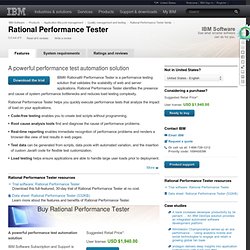
Performance Test Tools Comparison. Approaches to Performance Testing. By Matt Maccaux Originally published on BEA Dev2Dev September 2005 Abstract There are many different ways to go about performance testing enterprise applications, some of them more difficult than others.
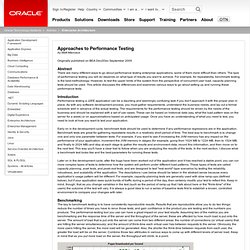
The type of performance testing you will do depends on what type of results you want to achieve. For example, for repeatability, benchmark testing is the best methodology. Introduction Performance testing a J2EE application can be a daunting and seemingly confusing task if you don't approach it with the proper plan in place. Early on in the development cycle, benchmark tests should be used to determine if any performance regressions are in the application. Later on in the development cycle, after the bugs have been worked out of the application and it has reached a stable point, you can run more complex types of tests to determine how the system will perform under different load patterns.
Benchmarking. Basic Approaches to Performance Testing. In which I shall attempt to state that there are 3 and only 3 approaches to performance testing… 1.
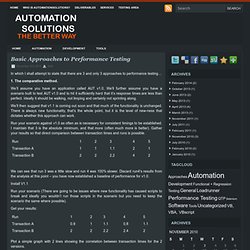
The comparative method. We’ll assume you have an application called AUT v1.0, We’ll further assume you have a scenario built to test AUT v1.0 and to hit it sufficiently hard that it’s response times are less than perfect. Ideally it should be walking, not limping and certainly not sprinting along. We’ll then suggest that v1.1 is coming out soon and that much of the functionality is unchanged. Run your scenario against v1.0 as often as is necessary for consistent timings to be established. We can see that run 3 was a little slow and run 4 was 100% slower.
Install V1.1. Load_testing.pdf (objeto application/pdf) Performance Testing Guidance for Web Applications. J.D.
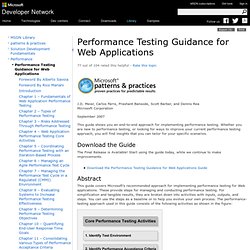
Meier, Carlos Farre, Prashant Bansode, Scott Barber, and Dennis Rea Microsoft Corporation September 2007 This guide shows you an end-to-end approach for implementing performance testing. Whether you are new to performance testing, or looking for ways to improve your current performance testing approach, you will find insights that you can tailor for your specific scenarios. Download the Guide The Final Release is Available! Download the Performance Testing Guidance for Web Applications Guide Abstract This guide covers Microsoft's recommended approach for implementing performance testing for Web applications. Parts Part 1, Introduction to Performance Testing Part II, Exemplar Performance Testing Approaches Part III, Identify the Test Environment Part IV, Identify Performance Acceptance Criteria Part V, Plan and Design Tests Part VI, Execute Tests Part VII, Analyze Results and Report Part VIII, Performance Testing Techniques Forewards Chapters Introduction Part V, Plan and Design Tests.
Creating-performance-test-methodology.pdf (objeto application/pdf) Performance testing approach.pdf (objeto application/pdf)